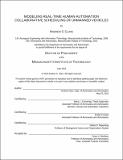| dc.contributor.advisor | Mary L. Cummings. | en_US |
| dc.contributor.author | Clare, Andrew S | en_US |
| dc.contributor.other | Massachusetts Institute of Technology. Department of Aeronautics and Astronautics. | en_US |
| dc.date.accessioned | 2013-11-18T20:39:27Z | |
| dc.date.available | 2013-11-18T20:39:27Z | |
| dc.date.copyright | 2013 | en_US |
| dc.date.issued | 2013 | en_US |
| dc.identifier.uri | http://hdl.handle.net/1721.1/82469 | |
| dc.description | Thesis (Ph. D.)--Massachusetts Institute of Technology, Dept. of Aeronautics and Astronautics, 2013. | en_US |
| dc.description | This electronic version was submitted and approved by the author's academic department as part of an electronic thesis pilot project. The certified thesis is available in the Institute Archives and Special Collections. | en_US |
| dc.description | Cataloged from department-submitted PDF version of thesis. | en_US |
| dc.description | Includes bibliographical references (p. 325-336). | en_US |
| dc.description.abstract | Recent advances in autonomy have enabled a future vision of single operator control of multiple heterogeneous Unmanned Vehicles (UVs). Real-time scheduling for multiple UVs in uncertain environments will require the computational ability of optimization algorithms combined with the judgment and adaptability of human supervisors. Automated Schedulers (AS), while faster and more accurate than humans at complex computation, are notoriously "brittle" in that they can only take into account those quantifiable variables, parameters, objectives, and constraints identified in the design stages that were deemed to be critical. Previous research has shown that when human operators collaborate with AS in real-time operations, inappropriate levels of operator trust, high operator workload, and a lack of goal alignment between the operator and AS can cause lower system performance and costly or deadly errors. Currently, designers trying to address these issues test different system components, training methods, and interaction modalities through costly human-in-the-loop testing. Thus, the objective of this thesis was to develop and validate a computational model of real-time human-automation collaborative scheduling of multiple UVs. First, attributes that are important to consider when modeling real-time human-automation collaborative scheduling were identified, providing a theoretical basis for the model proposed in this thesis. Second, a Collaborative Human-Automation Scheduling (CHAS) model was developed using system dynamics modeling techniques, enabling the model to capture non-linear human behavior and performance patterns, latencies and feedback interactions in the system, and qualitative variables such as human trust in automation. The CHAS model can aid a designer of future UV systems by simulating the impact of changes in system design and operator training on human and system performance. This can reduce the need for time-consuming human-in-the-loop testing that is typically required to evaluate such changes. It can also allow the designer to explore a wider trade space of system changes than is possible through prototyping or experimentation. Through a multi-stage validation process, the CHAS model was tested on three experimental data sets to build confidence in the accuracy and robustness of the model under different conditions. Next, the CHAS model was used to develop recommendations for system design and training changes to improve system performance. These changes were implemented and through an additional set of human subject experiments, the quantitative predictions of the CHAS model were validated. Specifically, test subjects who play computer and video games frequently were found to have a higher propensity to over-trust automation. By priming these gamers to lower their initial trust to a more appropriate level, system performance was improved by 10% as compared to gamers who were primed to have higher trust in the AS. The CHAS model provided accurate quantitative predictions of the impact of priming operator trust on system performance. Finally, the boundary conditions, limitations, and generalizability of the CHAS model for use with other real-time human-automation collaborative scheduling systems were evaluated. | en_US |
| dc.description.statementofresponsibility | by Andrew S. Clare. | en_US |
| dc.format.extent | 336 p. | en_US |
| dc.language.iso | eng | en_US |
| dc.publisher | Massachusetts Institute of Technology | en_US |
| dc.rights | M.I.T. theses are protected by
copyright. They may be viewed from this source for any purpose, but
reproduction or distribution in any format is prohibited without written
permission. See provided URL for inquiries about permission. | en_US |
| dc.rights.uri | http://dspace.mit.edu/handle/1721.1/7582 | en_US |
| dc.subject | Aeronautics and Astronautics. | en_US |
| dc.title | Modeling real-time human-automation collaborative scheduling of unmanned vehicles | en_US |
| dc.type | Thesis | en_US |
| dc.description.degree | Ph.D. | en_US |
| dc.contributor.department | Massachusetts Institute of Technology. Department of Aeronautics and Astronautics | |
| dc.identifier.oclc | 862118508 | en_US |
